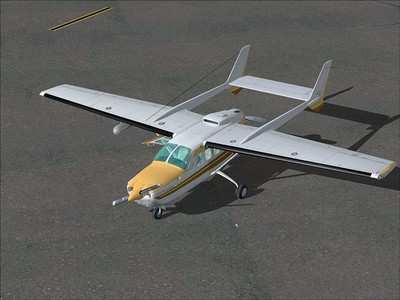 Recent NTSB reports suggest that
there may be some problems in the way that ATC works with pilots in
terms of realying weather information. Like the sad recent final
report published on the accident that claimed the life of famed
aviator Scott Crossfield, a 2005 P337 accident may have been
avoided had controllers provided more timely weather info on the
route of flight.
Recent NTSB reports suggest that
there may be some problems in the way that ATC works with pilots in
terms of realying weather information. Like the sad recent final
report published on the accident that claimed the life of famed
aviator Scott Crossfield, a 2005 P337 accident may have been
avoided had controllers provided more timely weather info on the
route of flight.
The NTSB report shows that Skymaster pilot Michael Zinn asked
for assistance in dealing with severe WX, but apparently did not
receive it. Zinn was a wealthy businessman who often traveled
between Boca Raton and New York, and left Boca Raton Airport aboard
N5HU, a Cessna P337H on Oct. 19, 2005, enroute to New York.
The NTSB summarized that, "While on an IFR flight, the pilot was
advised by the controller of an area of moderate to heavy
precipitation at his twelve o-clock position five miles ahead. The
pilot stated he would deviate around the weather on a 300 degree
heading. Examination of recorded display data showed that when the
pilot advised that he would be turning to a 300 degree heading to
avoid weather, the controller's display was showing moderate (Level
2) and heavy (Level 3 to 4) and intense to extreme (Level 5 to 6)
weather in that direction. The controller did not advise the pilot
of the depicted weather as required by FAA Order 7110.65, paragraph
2-6-4, 'Weather and Chaff Services.'
Review of weather radar images confirmed that shortly
thereafter, the airplane penetrated an intense Level 5
thunderstorm. About 1 minute after the heading change, the pilot
asked the controller if his heading was clear of weather, to which
the controller responded that he could not suggest any headings.
About 2 minutes later, the pilot asked the controller if there was
weather ahead of him, and the controller did not respond. About 30
seconds later, the pilot again asked about weather in front of him
and reported he was in 'difficult shape.' The controller responded
that he showed the airplane encountering "extreme precipitation"
and asked the pilot his intentions.

The pilot requested a heading and the controller responded with
a suggestion that the pilot turn 20 degrees right. The pilot
acknowledged and shortly thereafter, the airplane entered a rapid
descent. Several witnesses stated that they saw the airplane emerge
from the clouds at an altitude of about 300 feet, on its side, and
descending. They observed the airplane maneuvering erratically
before it descended and impacted a house at a steep angle. A fire
erupted, which destroyed the house and the airplane. According to
witnesses 'bad weather' was present in the area at the time of the
accident, with heavy rain and lightning being observed. A
Convective SIGMET was current for an area of thunderstorms with
tops to 40,000 feet, moving little."
The National Transportation Safety Board determines the
probable cause(s) of this accident as follows:
The pilot's continued flight into an area of known convective
weather, resulting in a loss of aircraft control. Contributing
factors were the failure of the FAA center controller to provide
information on depicted severe weather to the pilot and the
controller's delay in providing requested navigational assistance
until it was too late to provide the pilot with effective
assistance in avoiding severe weather.
 Airborne 05.10.24: Icon Auction, Drunk MedEvac Pilot, Bell ALFA
Airborne 05.10.24: Icon Auction, Drunk MedEvac Pilot, Bell ALFA ANN's Daily Aero-Term (05.13.24): ILS PRM Approach
ANN's Daily Aero-Term (05.13.24): ILS PRM Approach ANN's Daily Aero-Linx (05.13.24)
ANN's Daily Aero-Linx (05.13.24) Airborne-NextGen 05.07.24: AI-Piloted F-16, AgEagle, 1st 2 WorldView Sats
Airborne-NextGen 05.07.24: AI-Piloted F-16, AgEagle, 1st 2 WorldView Sats Airborne 05.08.24: Denali Update, Dad-Daughter Gyro, Lake SAIB
Airborne 05.08.24: Denali Update, Dad-Daughter Gyro, Lake SAIB




